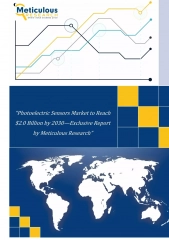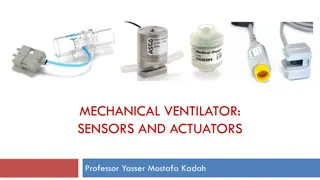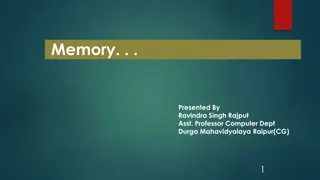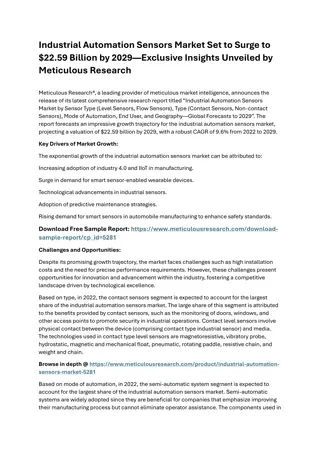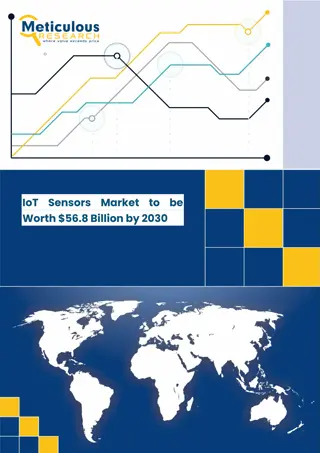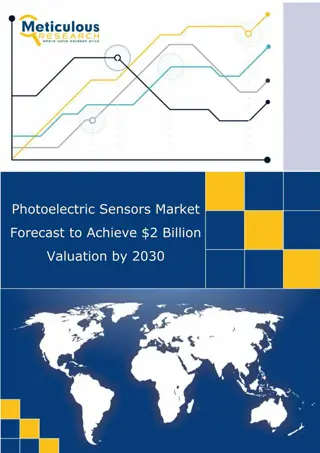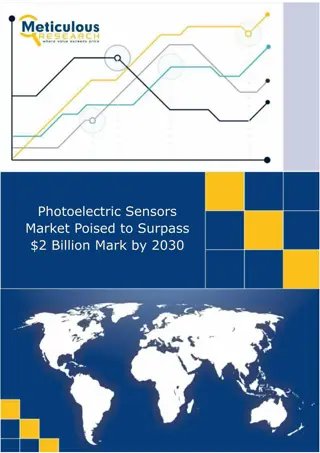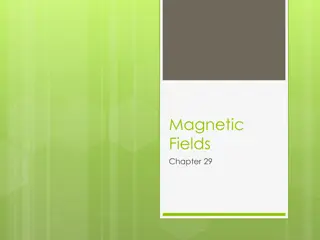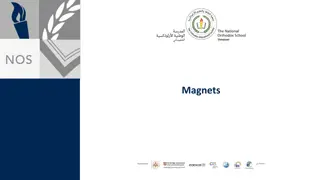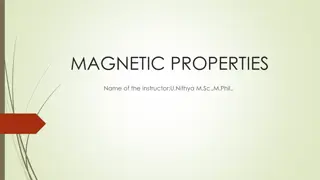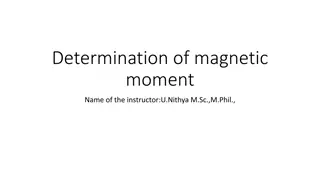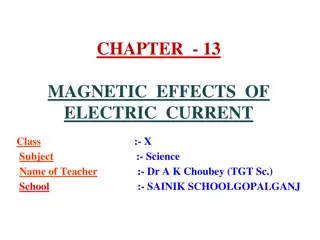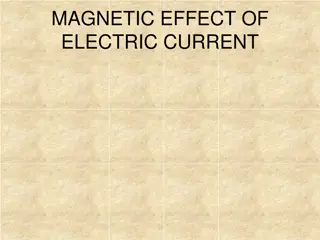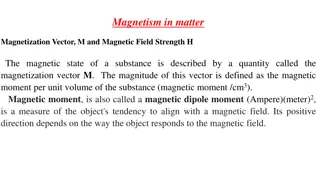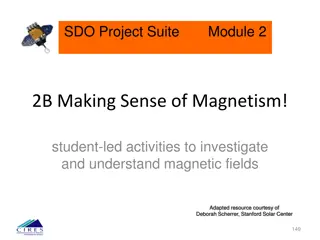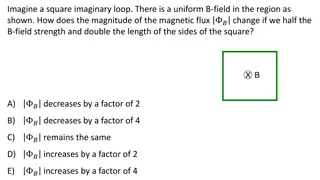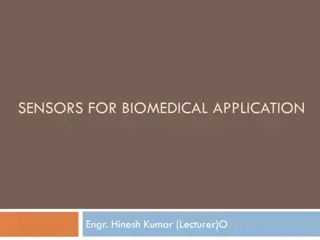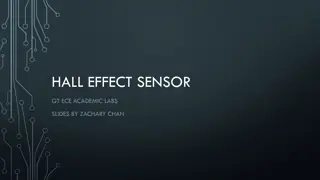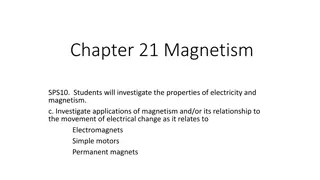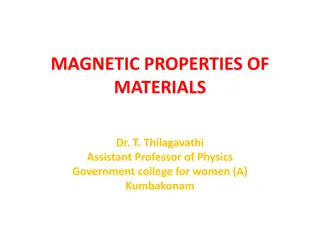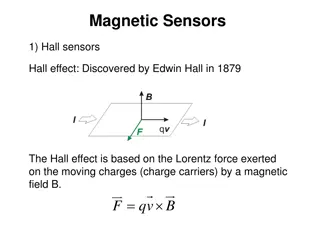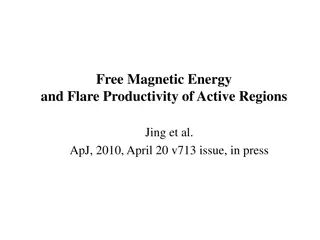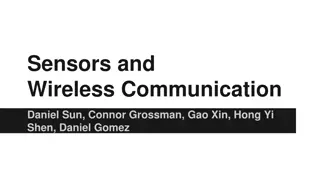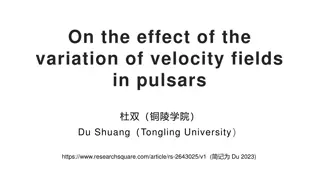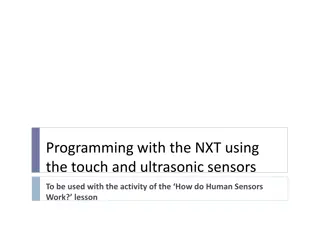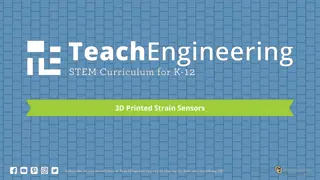Photoelectric Sensors Market to Reach $2.0 Billion by 2030—Exclusive Report by Meticulous Research
Photoelectric Sensors Market by Sensing Type (Diffuse-reflective Sensors, Retro-reflective Sensors), Sensing Distance, Structure (Amplifier Built-in, Power Supply Built-in), Beam Source, Output, End Use, and Geography - Global Forecast to 2030\n
1 views • 5 slides
Understanding Ampere's Law and Magnetic Fields in Wires
Explore the basic premise and elementary applications of Ampere's Law in calculating magnetic fields around wires. Learn how to determine the magnetic field strength at various distances from a wire carrying current, and comprehend the force between two parallel wires due to magnetic fields. Dive in
7 views • 11 slides
Understanding AGN Jet Production Efficiency: Insights from Spin and Magnetic Flux
A fundamental question in astrophysics is how efficiently active galactic nuclei (AGN) produce jets. Black hole spin and magnetic flux play crucial roles in determining the jet production efficiency. High-spin values and large magnetic flux threading are essential for generating high-efficiency jets
2 views • 22 slides
Basic Principles of MRI Imaging
MRI, or Magnetic Resonance Imaging, is a high-tech diagnostic imaging tool that uses magnetic fields, specific radio frequencies, and computer systems to produce cross-sectional images of the body. The components of an MRI system include the main magnet, gradient coils, radiofrequency coils, and the
2 views • 49 slides
Understanding Mechanical Ventilator Sensors and Actuators
Explore the essential components of mechanical ventilators, including sensors like pressure and flow sensors, actuators, and oxygen sensors. Learn about the functions and characteristics of these sensors and how they contribute to the operation of mechanical ventilators designed to assist patients w
6 views • 20 slides
Understanding Magnetic Disks and Disk Controllers in Computer Memory Hierarchy
Auxiliary memory in computer systems provides additional backup storage through technologies like magnetic disks and tapes. Magnetic disks, which consist of circular platters coated with magnetizable material, offer direct access storage and are controlled by read/write mechanisms and disk controlle
10 views • 42 slides
Industrial Automation Sensors Market Set to Surge to $22.59 Billion by 2029
Industrial Automation Sensors Market by Sensor Type (Level Sensors, Flow Sensors), Type (Contact Sensors, Non-contact Sensors), Mode of Automation, End User, and Geography - Global Forecast to 2029
2 views • 2 slides
IoT Sensors Market - Global Opportunity Analysis and Industry Forecast (2023-203
IoT Sensors Market by Offering (Image Sensors, RFID Sensors, Biosensors, Humidity Sensors, Optical Sensors, Others), Technology (Wired, Wireless), Sector (Manufacturing, Retail, Consumer Electronics, Others), & Geography - Global Forecast to 2030\n
3 views • 4 slides
Smart Sensors Market
Smart Sensors Market by Component (Transceivers, Amplifiers), Technology (Optic, Ultrasonic), Application (Remote Monitoring, Wearable Devices), Sensor Type (Image Sensors, Pressure Sensors), End User (Automotive, Retail, BFSI), and Geography- Global Forecast to 2030\n
2 views • 6 slides
Photoelectric Sensors Market Forecast to Achieve $2 Billion Valuation by 2030
This comprehensive market analysis delves into the diverse landscape of photoelectric sensors, considering various parameters such as sensing type (including diffuse-reflective sensors and retro-reflective sensors), sensing distance, structure (with options like amplifier built-in or power supply bu
0 views • 5 slides
Photoelectric Sensors Market
This comprehensive market analysis delves into the diverse landscape of photoelectric sensors, considering various parameters such as sensing type (including diffuse-reflective sensors and retro-reflective sensors), sensing distance, structure (with options like amplifier built-in or power supply bu
0 views • 4 slides
Exploring Magnetic Fields and Earth's Magnetism
Uncover the fascinating world of magnetic fields, from the historical discoveries of magnetism to understanding the Earth's magnetic field and its poles. Dive into the concepts of magnetic forces, field lines, and the direction of Earth's magnetic field over time. Discover the properties of magnetic
1 views • 24 slides
Understanding Semiconductor Sensors and their Applications
Semiconductor sensors are versatile devices that utilize semiconductor materials like silicon for detecting and measuring various non-electrical quantities. These sensors leverage the unique properties of silicon, such as high tensile strength, Young Modulus, and resistance to corrosion, making them
1 views • 26 slides
Understanding Magnets and Magnetic Fields
Explore the fascinating world of magnets and magnetic materials. Discover how magnets have two poles, North and South, and how they interact with each other. Learn about magnetic materials like iron, cobalt, and nickel, and understand the concept of magnetizing and demagnetizing. Dive into the magne
0 views • 15 slides
Gas Detector Alarms Market Future Prospects 2030
Global Gas Detector Alarms Market Breakdown by Type (Electrochemical sensors, Catalytic sensors, Infrared sensors, Photoionization sensors, Others) by Modality (Portable, Fixed) by End-Use Industry (Oil & Gas, Chemical & Petrochemical, Metal & Mining
1 views • 8 slides
Understanding Magnetic Properties and Types of Magnetism
Explore the fundamentals of magnetic properties and types of magnetism in this detailed guide. Learn about magnetic permeability, magnetic susceptibility, paramagnetism, diamagnetism, ferromagnetism, antiferromagnetism, and ferrimagnetism. Understand the magnetic moments of spinning electrons, orbit
2 views • 28 slides
Understanding Magnetic Moments and Susceptibilities in Materials
Determination of magnetic moment and susceptibility plays a crucial role in studying the magnetic properties of materials. This involves methods like Guoy balance for paramagnetic substances and observing weight changes for diamagnetic substances. The Faraday method, employing a quartz container in
0 views • 20 slides
Magnetic Field Problems: Protons, Wires, and Charged Ions
Solve various problems related to magnetic fields, including determining forces on protons, calculating magnetic forces on wires with currents, finding the radius of paths for charged ions in magnetic fields, and more. Understand concepts such as magnetic forces, circular orbits, and interactions be
1 views • 10 slides
Magnetic Force and Acceleration of Electrons in Television Picture Tubes
An electron in a television picture tube is analyzed as it moves towards the front of the tube in a magnetic field. The magnetic force and acceleration of the electron are calculated, along with determining the linear speed of a proton moving in a circular orbit under a magnetic field. Additionally,
0 views • 6 slides
Understanding Magnetic Effects of Electric Current in Science Class
Explore the magnetic field and field lines, understand the magnetic effects of current-carrying conductors, learn about the right-hand thumb rule, and discover the magnetic field due to current through a circular loop in Chapter 13 of Magnetic Effects of Electric Current in Science Class at Sainik S
0 views • 17 slides
Understanding Industrial Automation Components and Sensors
Explore the world of industrial automation through field instruments, control hardware, and advanced technology like SCADA software and smart transmitters. Learn about widely used sensors in automation, leading manufacturers, and control hardware such as PLCs and distributed control systems. Dive in
2 views • 8 slides
Exploring the Magnetic Effect of Electric Current
Understanding electromagnetism involves recognizing how an electric current in a conductor generates a magnetic field around it. This phenomenon was first observed by Hans Ørsted in 1820, leading to discoveries about magnetic field patterns for various conductor shapes. By studying straight wires,
0 views • 30 slides
Understanding Magnetism in Matter: Magnetization and Magnetic Field Strength
The magnetic state of a substance is characterized by the magnetization vector M, representing the magnetic moment per unit volume. The total magnetic field induction at a point within a substance depends on the applied field and magnetization M. Substances can be classified as paramagnetic, ferroma
2 views • 11 slides
Understanding Magnetic Fields Through Student-Led Activities
Explore the fascinating world of magnetism with student-led activities to investigate and comprehend magnetic fields. Discover the properties of magnetic poles, observe magnetic field lines, and learn about the history and significance of magnets on Earth. Engage in hands-on experiments and discussi
0 views • 12 slides
Understanding Magnetic Flux and Induced Current in Loops
Explore concepts related to magnetic flux and induced current in loops through visual scenarios involving uniform magnetic fields, loop movements, and changes in magnetic flux. Test your understanding with multiple-choice questions on induced EMF, loop bending, and maximizing magnetic flux. Enhance
1 views • 54 slides
Understanding Sensors in Biomedical Applications
Explore the world of sensors in biomedical applications with insights on transducers, active vs. passive sensors, common sensor types, error sources, and examples of sensors used in medical instruments. Learn about the functions and distinctions between sensors, transducers, and actuators, along wit
3 views • 64 slides
Understanding Hall Effect Sensors in Electronic Labs
Hall Effect sensors play a crucial role in detecting magnetic fields, enabling applications such as current sensing, rotational speed measurement in motors, and magnetic proximity sensing. They operate based on the Hall Effect phenomenon, where a magnetic field influences the flow of current in a se
2 views • 5 slides
Overview of Low-Cost Sensors for Atmospheric Composition Measurement
This publication provides an insightful overview of low-cost sensors for measuring atmospheric composition, covering topics like sensor technologies, applications in atmospheric sciences and air quality management, and evaluation methods. It emphasizes the importance of not only the technical perfor
0 views • 17 slides
Basics of Compass Surveying and Magnetic Bearings
Compass surveying involves the use of compasses to determine directions and bearings during surveying activities. This method utilizes tools like prismatic compasses and magnetic needles to establish true and magnetic meridians, as well as arbitrary and grid meridians. Understanding concepts like wh
0 views • 17 slides
Exploring Magnetism: Properties, Forces, and Applications
Investigate the properties of magnetism, magnetic forces, magnetic fields, and magnetic materials. Understand how magnetic forces work, the behavior of magnetic fields, and the significance of magnetic materials such as ferromagnetic substances. Explore applications like electromagnets, simple motor
0 views • 19 slides
Understanding Magnetic Properties of Materials in Physics
Explore the magnetic properties of materials through concepts such as basic magnetism, hysteresis, electromagnetic force, permeability, coercive force, and magnetic flux density. Delve into the study of magnetic fields, lines of force, and their applications in various engineering materials and magn
0 views • 17 slides
Understanding Bubble Size Distribution Using Magnetic Particle Tracking
Explore the methodology of determining bubble size distribution in fluid beds through Magnetic Particle Tracking (MPT). Learn about MPT key features, information obtained from 3D trajectory data, and the application of MPT for characterizing fluidized solids behavior. The usage of magnetic tracers a
0 views • 24 slides
Understanding Hall Effect in Magnetic Sensors
The Hall effect, discovered by Edwin Hall in 1879, is utilized in magnetic sensors to detect magnetic fields by measuring the Lorentz force on moving charges. Hall sensors generate a Hall voltage based on the positive and negative charge carriers present. Integrated Hall sensors provide detailed spe
0 views • 10 slides
Understanding Magnetic Resonance Imaging (MRI)
Magnetic Resonance Imaging (MRI) is an imaging technique based on nuclear magnetic resonance principles. It was first developed in the 1970s by Paul Lauterbur and Peter Mansfield. MRI uses the interaction between protons in the body and magnetic fields to create detailed images. This technology has
0 views • 77 slides
Understanding the Relationship Between Free Magnetic Energy and Solar Flare Productivity
This study examines the correlation between free magnetic energy and flare productivity in active regions on the Sun. By analyzing data from solar events and magnetic field observations, researchers investigate the temporal variation of free magnetic energy and its impact on flare occurrence. Variou
0 views • 12 slides
Understanding Semiconductor Sensors in Sensor Technology
Introduction to semiconductor sensors, focusing on the properties of silicon that make it a preferred material for smart sensor development. Discusses the application of semiconductor sensors, planar silicon technology, and modern pressure sensors integrated with silicon diaphragms. Covers the mater
0 views • 15 slides
Understanding Sensors and Wireless Communication in Technology
Exploring the world of sensors and wireless communication through LED technology, electro-optical sensors, chemiresistors, and more. Learn how LEDs work, the principles behind electro-optical sensors, and the implementation of these technologies in various applications. Discover the intricate mechan
0 views • 28 slides
Impact of Velocity Field Variations on Pulsar Magnetic Fields
The study explores how variations in velocity fields affect pulsar magnetic fields, highlighting the conversion of kinetic energy to magnetic energy in pulsars. Glitches in these systems can lead to changes in magnetic fields, influencing pulsar emissions. The maintenance of stable magnetic fields a
0 views • 14 slides
Programming with Sensors: NXT Touch & Ultrasonic Sensors in Action
Explore how to incorporate touch and ultrasonic sensors into your robot programs using the NXT MINSTORMS software. Learn about the wait for command, sensor integration, and enhancing robot navigation with sensors. Get hands-on guidance on utilizing wait for touch and wait for distance commands effec
0 views • 17 slides
Understanding 3D Printed Strain Sensors: How They Work and Their Benefits
3D printed strain sensors are custom-made sensors printed by a 3D printer using materials that conduct electricity. They work by measuring electrical resistance, which changes with environmental conditions. These sensors are cost-effective, easily customizable, and can be integrated into wearable te
0 views • 7 slides
